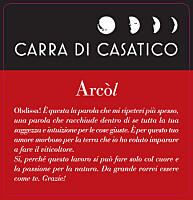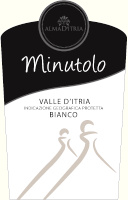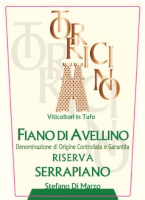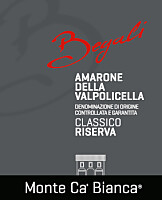
Wine Culture and Information since 2002 - Volume 22
 Wine Culture and Information since 2002 - Volume 22 |
|
Contrasts of Bardolino Classico Chiaretto and Salice Salentino RosatoThis month we color our glasses pink by comparing two distant and different wines, expressions of two distant regions that only have style and color in common. |
|
Rosé wines are living, so to speak, a second youth. For some years – and this is a decidedly positive fact – wine enthusiasts have rediscovered, or perhaps discovered for the first time, the pleasure of seeing their glass colored pink. This has happened also thanks to the activity of the consortia of the denominations that provide for the production of rosé wines, with the full support of the producers who – for their part – have understood the importance of quality in the success of this style of wine. It should in fact be noted that, in times not too distant, rosé wines were often considered second line wines, placed on a lower level than the production of red and white wines. In the past, in fact, rosé wines were often the result of the “bleeding” of red wines, that is, a portion of “rosé must” was taken from the red wine fermentation tanks with the aim of obtaining a greater concentration of color and polyphenols. This practice is still in use today, of course, but it is evident that the quality and dignity of rosé wines has increased significantly in recent years. Today, at last, the majority of rosé wines are the result of a specific production practice that was expressly created and developed with the sole result of obtaining a rosé wine and not the by-product of another wine production. It should be noted, in fact, rosé wine is produced with a specific and particular technique, which involves a short maceration of the must from red grapes with their own skins. At the end of this phase – which generally ends in less than ten hours, rarely more than twelve and depending on the type of grape – the skins are separated from the must and the wine making proceeds until the final product is obtained, that is, a rosé wine. This month's tasting by contrast compares two famous wines belonging to this category and defined in specific production disciplinary: Bardolino Classico Chiaretto and Salice Salentino Rosato.
|
|
Bardolino is certainly one of the most famous and important denominations in the province of Verona, Italy. The production of this territory – which extends on the right bank of Lake Garda up to the municipalities on the outskirts of Verona – besides providing red wines, including the “Superiore”, recognized as a Denominazione d'Origine Controllata e Garantita (Denomination of Controlled and Guaranteed Origin, DOCG), it also produces a particular rosé wine, known as Chiaretto (Italian for “claret”). The name, decidedly evocative, underlines the typically “pale” color compared to the red of the area, as pale as deserving the name “Chiaretto”. The composition of the grapes is exactly the same provided for the red wines of Bardolino denomination and, among these, Corvina represents the main share. This variety, in fact, must be present for at least 35% and up to a maximum of 95%, admitting a maximum presence of 20% of Corvinone replacing Corvina. The complementary part is made up of Rondinella, for a minimum of 5% up to a maximum of 40%, possibly other red grapes allowed for cultivation in the province of Verona and for a maximum of 20%. These varieties also include Molinara, a typical and historic grape of the area, which can be present for a maximum of 15%. As regards the “Classico” designation – to which the wine we will pour into our glass belongs – it is only permitted for wines of the denomination produced in the municipalities of Bardolino, Garda, Lazise, Affi, Costermano and Cavaion. According to tradition, Chiaretto was produced in 1896 on Lake Garda by the Venetian senator, lawyer and writer Pompeo Molmenti. At that time he was in the village of Moniga del Garda and, by using the “white” winemaking technique learned in France with the typical red grapes of the area, he gave life to the “Chiaretto”. The success of the new wine was such that, in 1970, the wine journalist Zeffiro Bocci, in one of his articles summarizing the history of Venetian wines, stated that «in the Veronese wine-growing areas adjacent to Benaco (alternative name of Lake Garda), a well-defined Chiaretto del Garda has always been produced».
|
||||
|
Apulia and Salento have a deep connection with rosé wines, probably like no other Italian region or territory. Here, in fact, except for few cases, the denominations providing for the production of wines with red berried grapes also include that of rosés with the same varieties. The Denominazione d'Origine Controllata Salice Salentino (Denomination of Controlled Origin, DOC) of course, is no exception. The rosé style – in fact – represents the foundation of the entire denomination and is the style of wine that contributed most to the reconstitution and success of the viticulture of Salento, and therefore of Apulia, at the end of the Second World War. Salento's connection with wine, however, has decidedly more ancient roots and it is believed that the vine was present in these lands as early as 2000 BC. A bond so ancient that it has even influenced the local dialect, so much so that here the wine is called mjiere, mjier or mieru, clearly derived from the Latin merus, that is `pure”, “frank”. In this regard, it must also be said that in past times – specifically, those of ancient Rome – merum became synonymous with vinum – that is, wine – and was used when it was not mixed with other substances or water, therefore “pure”. The queen grape of Salento, also of its rosé wine, is Negroamaro which – according to the production disciplinary – must be present for at least 75%, while the remaining part can be made up of red berried grapes allowed for cultivation in Apulia region. In this regard, it should be noted that, in the majority of cases, this part is made of Malvasia Nera, a composition that mainly reflects the historical tradition of blending these two grapes for the production of local red and rosé wines. Salice Salentino Rosato usually expresses qualities of immediacy and crispness, often vinified in inert containers with the purpose of further enhancing the fruity character of Negroamaro and, not least, of Malvasia Nera.
|
Let's start this month's tasting by contrast and, before pouring the two wines into the glasses, let's find the bottles to be examined. Bardolino Classico Chiaretto and Salice Salentino Rosato are wines which are not so difficult to get, as they are quite widespread and can be easily purchased in any well-stocked wine shop. The production disciplinary of both wines allow the use of multiple varieties, therefore we will pay attention to their composition. As for Bardolino Classico Chiaretto, we will choose a bottle produced with Corvina, Rondinella and Molinara. The choice of Salice Salentino Rosato is determined by, so to speak, traditional and historical factors, therefore we will choose a bottle produced exclusively with Nergoamaro and Malvasia Nera. Both wines belong to the most recent harvest and will be served in tasting glasses at a temperature of 12 °C. (54 °F) After having poured Bardolino Classico Chiaretto and Salice Salentino Rosato into their respective tasting glasses, we can begin the organoleptic evaluation of the two wines, starting with the analysis of their appearance, that is, how they present themselves to the eye in terms of color and transparency. The first wine we examine is Bardolino Classico Chiaretto therefore, by tilting the glass over a white surface, we observe the base in order to evaluate the color and transparency. The Venetian wine presents itself to the eye with a light cherry pink color and good transparency, confirmed by the vision of the object placed in contrast between the glass and the white surface. Let's now observe the nuance of Bardolino Classico Chiaretto – towards the opening of the glass, where the thickness of the wine becomes thin – which confirms the light cherry pink base tone. Let's now pass on to evaluating the color of Salice Salentino Rosato and, by tilting the glass over the white surface, let's observe the base. In the Apulian wine we see an intense cherry pink color and generally darker than Bardolino Classico Chiaretto, however showing good transparency. The nuances of the wine is also intense cherry pink. The olfactory profiles of Bardolino Classico Chiaretto and Salice Salentino Rosato express very distinct characteristics on the nose, mainly due to the composition of the grapes and the respective territories. In Bardolino Classico Chiaretto – result of the blending of Corvina, Rondinella and Molinara – we can mainly perceive aromas of red pulp fruits, including raspberry, cherry and strawberry, as well as sensations of citrus fruits, mainly represented by tangerine and citron. The world of flowers of Bardolino Classico Chiaretto is generally expressed in the aromas of cyclamen and dog rose. In the olfactory profile of Salice Salentino Rosato mainly dominate the aromas of cherry, strawberry and blueberry, as well as raspberry, plum, peach and pomegranate. Furthermore, in the Apulian rosé wine, can also be clearly perceived aromas recalling flowers, in particular cyclamen, rose and hawthorn. Finally, Salice Salentino Rosato can sometimes express a pleasing hint of anise on the nose. Let's continue the tasting of the two wines of this month and proceed with the analysis of the olfactory profile of Bardolino Classico Chiaretto. Let's hold the glass in vertical position and, without swirling, do the first smell in order to appreciate the opening of the wine, that is, its primary and identifying aromas. On the nose we can perceive – intense and clean – aromas of raspberry, cherry and strawberry, followed by floral sensations reminiscent of dog rose and cyclamen. After having swirled the glass – an operation favoring the development of the other aromas – the olfactory profile of the Venetian rosé wine is completed with tangerine and citron, as well as blackberry and peach. Let's now move on to the evaluation of the olfactory profile of Salice Salentino Rosato and – by holding the glass in vertical position and without swirling – let's proceed with the evaluation of its opening. From the glass we can perceive intense and clean aromas of cherry, strawberry and blueberry, as well as floral aromas reminiscent of cyclamen and rose. After having swirled the glass, the profile of the Apulian wine is completed with aromas of blackberry, plum, pomegranate and peach. Let's now move on to the evaluation of the gustatory profiles of the two wines of our tasting by contrast, starting – as in the previous phases – from the examination of Bardolino Classico Chiaretto. Let's take the first sip of the Venetian wine, an operation allowing us to evaluate the attack, that is, the primary and identifying gustatory sensations. In the mouth we perceive a pleasing and intense crispness given by the acidity, a sensation which promptly finds balance thanks to the effect of the alcohol. The wine has a good body and in the mouth we can perceive flavors of raspberry, cherry and strawberry. Let's move on to the evaluation of the gustatory profile of Salice Salentino Rosato and then proceed with the analysis of its attack. After the first sip, the Apulian rosé wine expresses a marked crispness in the mouth given by the acidity – generally rounder than Bardolino Classico Chiaretto – also in this case balanced by the effect of the alcohol. In the mouth can be perceived, in addition to the good structure, flavors of cherry, strawberry, blueberry and blackberry. The final phase of the tasting focuses on the evaluation of taste-olfactory persistence, that is the measurement of the time during which it is possible to perceive the gustatory and aromatic qualities of the wine in the mouth after swallowing. The finish of Bardolino Classico Chiaretto is of good persistence and in the mouth we can continue to clearly perceive the flavors of raspberry, cherry and strawberry, as well as the pleasing sensation of crispness. The finish of Salice Salentino Rosato is equally persistent and, after swallowing, it is possible to continue perceiving the pleasing crispness and sensation of good body, generally more robust than Bardolino Classico Chiaretto. Furthermore, in the mouth are also clearly perceived the flavors of cherry, strawberry, blueberry and blackberry. Before concluding this month's tasting by contrast, let's evaluate the olfactory profiles of the two wines again. With the glasses side to side, let's proceed by smelling Bardolino Classico Chiaretto and then Salice Salentino Rosato. Despite the profiles are characterized mainly by red pulp fruits, the two wines evidently express unique and distinct characters.
|
||||||||
Wines of the Month |
|
|
|
Score legend Prices are to be considered as indicative. Prices may vary according to the country or the shop where wines are bought |
|
|
|
Colli di Parma Malvasia Spumante Extra Dry Acuto 2021 |
|
| Carra di Casatico (Emilia-Romagna, Italy) | |
 Malvasia di Candia Aromatica Malvasia di Candia Aromatica | |
| Price: € 9.40 | Score: |
 Brilliant straw yellow and nuances of straw yellow, very transparent,
fine and persistent perlage. Brilliant straw yellow and nuances of straw yellow, very transparent,
fine and persistent perlage.
 Intense, clean, pleasing and refined, starts with hints of apple, pear
and peach followed by aromas of broom, hawthorn, jasmine, pineapple,
tangerine, plum and acacia honey. Intense, clean, pleasing and refined, starts with hints of apple, pear
and peach followed by aromas of broom, hawthorn, jasmine, pineapple,
tangerine, plum and acacia honey.
 Effervescent and crisp attack, however balanced by alcohol, good body,
intense flavors, pleasing sweet hint. Effervescent and crisp attack, however balanced by alcohol, good body,
intense flavors, pleasing sweet hint.
 Persistent finish with flavors of apple, pear and peach. Persistent finish with flavors of apple, pear and peach. Produced with the Charmat method and aged on its lees for at least 6
months. Produced with the Charmat method and aged on its lees for at least 6
months.
|
|
 Pasta and risotto with fish and crustaceans, Stewed crustaceans, Mushroom soups, Vegetable flans Pasta and risotto with fish and crustaceans, Stewed crustaceans, Mushroom soups, Vegetable flans |
|

|
|
Arcòl 2017 |
|
| Carra di Casatico (Emilia-Romagna, Italy) | |
 Croatina (50%), Merlot (30%), Pinot Nero (20%) Croatina (50%), Merlot (30%), Pinot Nero (20%) | |
| Price: € 12.80 | Score: |
 Deep ruby red and nuances of garnet red, little transparency. Deep ruby red and nuances of garnet red, little transparency. Intense, clean, pleasing and refined, starts with hints of black
cherry, plum and black currant followed by aromas of dried violet,
blueberry, cocoa, tobacco, leather, mace, vanilla and eucalyptus. Intense, clean, pleasing and refined, starts with hints of black
cherry, plum and black currant followed by aromas of dried violet,
blueberry, cocoa, tobacco, leather, mace, vanilla and eucalyptus.
 Properly tannic attack and however balanced by alcohol, good body,
intense flavors, agreeable. Properly tannic attack and however balanced by alcohol, good body,
intense flavors, agreeable.
 Persistent finish with flavors of black cherry, plum and black currant. Persistent finish with flavors of black cherry, plum and black currant. 12 months in barrique, 4 months in bottle. 12 months in barrique, 4 months in bottle. |
|
 Broiled meat and barbecue, Stewed meat with mushrooms, Roasted meat, Cheese Broiled meat and barbecue, Stewed meat with mushrooms, Roasted meat, Cheese |
|

|
|
Locorotondo Superiore Cinqueò Almaditria 2021 |
|
| Upal (Apulia, Italy) | |
 Verdeca, Bianco d'Alessano, Minutolo Verdeca, Bianco d'Alessano, Minutolo | |
| Price: € 11.00 | Score: |
 Brilliant golden yellow and nuances of golden yellow, very transparent. Brilliant golden yellow and nuances of golden yellow, very transparent. Intense, clean, pleasing and refined, starts with hints of apple, pear
and broom followed by aromas of hawthorn, jasmine, medlar, citrus fruits,
pineapple, plum and peach. Intense, clean, pleasing and refined, starts with hints of apple, pear
and broom followed by aromas of hawthorn, jasmine, medlar, citrus fruits,
pineapple, plum and peach.
 Crisp attack and however balanced by alcohol, good body, intense
flavors, pleasing roundness. Crisp attack and however balanced by alcohol, good body, intense
flavors, pleasing roundness.
 Persistent finish with flavors of apple, pear and medlar. Persistent finish with flavors of apple, pear and medlar. Aged in steel tanks. Aged in steel tanks. |
|
 Pasta with fish, Sauteed white meat, Sauteed fish, Stewed fish with mushrooms, Legume soups Pasta with fish, Sauteed white meat, Sauteed fish, Stewed fish with mushrooms, Legume soups |
|

|
|
Minutolo Almaditria 2022 |
|
| Upal (Apulia, Italy) | |
 Minutolo Minutolo | |
| Price: € 14.00 | Score: |
 Brilliant straw yellow and nuances of straw yellow, very transparent. Brilliant straw yellow and nuances of straw yellow, very transparent. Intense, clean, pleasing, refined and elegant, starts with hints of
apple, peach and citron followed by aromas of hawthorn, broom, jasmine,
pear, melon, pineapple, mango, plum, honey and mineral. Intense, clean, pleasing, refined and elegant, starts with hints of
apple, peach and citron followed by aromas of hawthorn, broom, jasmine,
pear, melon, pineapple, mango, plum, honey and mineral.
 Crisp attack and however balanced by alcohol, good body, intense
flavors, agreeable. Crisp attack and however balanced by alcohol, good body, intense
flavors, agreeable.
 Persistent finish with flavors of apple, peach and citron. Persistent finish with flavors of apple, peach and citron. Aged in steel tanks. Aged in steel tanks. |
|
 Pasta with fish and crustaceans, Stewed fish with mushrooms, Sauteed white meat, Vegetable flans, Dairy products Pasta with fish and crustaceans, Stewed fish with mushrooms, Sauteed white meat, Vegetable flans, Dairy products |
|

|
|
Fiano di Avellino Riserva Serrapiano 2021 |
|
| Torricino (Campania, Italy) | |
 Fiano Fiano | |
| Price: € 18.00 | Score: |
 Brilliant straw yellow and nuances of straw yellow, very transparent. Brilliant straw yellow and nuances of straw yellow, very transparent. Intense, clean, pleasing, refined and elegant, starts with hints of
apple, pear and pineapple followed by aromas of hawthorn, broom, jasmine,
peach, grapefruit, medlar, plum, hazelnut, linden and mineral. Intense, clean, pleasing, refined and elegant, starts with hints of
apple, pear and pineapple followed by aromas of hawthorn, broom, jasmine,
peach, grapefruit, medlar, plum, hazelnut, linden and mineral.
 Crisp attack and however balanced by alcohol, good body, intense
flavors, agreeable. Crisp attack and however balanced by alcohol, good body, intense
flavors, agreeable.
 Persistent finish with flavors of apple, pear and hazelnut. Persistent finish with flavors of apple, pear and hazelnut. 6 months in steel tanks. 6 months in steel tanks. |
|
 Pasta with fish and mushrooms, Stewed white meat, Stewed fish, Fish and mushroom soups Pasta with fish and mushrooms, Stewed white meat, Stewed fish, Fish and mushroom soups |
|

|
|
Taurasi Cevotiempo 2019 |
|
| Torricino (Campania, Italy) | |
 Aglianico Aglianico | |
| Price: € 25.00 | Score: |
 Intense ruby red and nuances of garnet red, little transparency. Intense ruby red and nuances of garnet red, little transparency. Intense, clean, pleasing, refined and elegant, starts with hints of
black cherry, plum and violet followed by aromas of carnation, dried rose,
blackberry, blueberry, carob, cocoa, tobacco, mace, leather, vanilla and
menthol. Intense, clean, pleasing, refined and elegant, starts with hints of
black cherry, plum and violet followed by aromas of carnation, dried rose,
blackberry, blueberry, carob, cocoa, tobacco, mace, leather, vanilla and
menthol.
 Properly tannic attack and however balanced by alcohol, full body,
intense flavors, pleasing crispness. Properly tannic attack and however balanced by alcohol, full body,
intense flavors, pleasing crispness.
 Persistent finish with flavors of black cherry, plum and blackberry. Persistent finish with flavors of black cherry, plum and blackberry. 24 months in cask, 12 months in bottle. 24 months in cask, 12 months in bottle. |
|
 Game, Roasted meat, Braised and stewed meat with mushrooms, Hard cheese Game, Roasted meat, Braised and stewed meat with mushrooms, Hard cheese |
|

|
|
Tigiolo 2018 |
|
| Begali (Veneto, Italy) | |
 Corvina (40%), Cabernet Sauvignon (40%), Rondinella (10%), Merlot (10%) Corvina (40%), Cabernet Sauvignon (40%), Rondinella (10%), Merlot (10%) | |
| Price: € 16.00 | Score: |
 Intense ruby red and nuances of garnet red, little transparency. Intense ruby red and nuances of garnet red, little transparency. Intense, clean, pleasing, refined and elegant, starts with hints of
plum, black currant and black cherry followed by aromas of dried violet,
blueberry, blackberry, cocoa, tobacco, licorice, leather, mace, vanilla and
eucalyptus. Intense, clean, pleasing, refined and elegant, starts with hints of
plum, black currant and black cherry followed by aromas of dried violet,
blueberry, blackberry, cocoa, tobacco, licorice, leather, mace, vanilla and
eucalyptus.
 Properly tannic attack and however balanced by alcohol, full body,
intense flavors, pleasing roundness. Properly tannic attack and however balanced by alcohol, full body,
intense flavors, pleasing roundness.
 Persistent finish with flavors of plum, black currant and black cherry. Persistent finish with flavors of plum, black currant and black cherry. Aged in cask and barrique. Aged in cask and barrique. |
|
 Game, Roasted meat, Braised and stewed meat, Hard cheese Game, Roasted meat, Braised and stewed meat, Hard cheese |
|

|
|
Amarone della Valpolicella Classico Riserva Monte Ca' Bianca 2017 |
|
| Begali (Veneto, Italy) | |
 Corvina (40%), Corvinone (35%), Rondinella (20%), Oseleta (5%) Corvina (40%), Corvinone (35%), Rondinella (20%), Oseleta (5%) | |
| Price: € 43.00 | Score: |
 Intense ruby red and nuances of garnet red, little transparency. Intense ruby red and nuances of garnet red, little transparency. Intense, clean, pleasing, refined and elegant, starts with hints of
blackberry, plum and dried violet followed by aromas of black cherry,
blueberry, tamarind, tobacco, chocolate, cinnamon, leather, licorice, mace,
vanilla and menthol. Intense, clean, pleasing, refined and elegant, starts with hints of
blackberry, plum and dried violet followed by aromas of black cherry,
blueberry, tamarind, tobacco, chocolate, cinnamon, leather, licorice, mace,
vanilla and menthol.
 Properly tannic attack and however balanced by alcohol, full body,
intense flavors, pleasing roundness. Properly tannic attack and however balanced by alcohol, full body,
intense flavors, pleasing roundness.
 Very persistent finish with long flavors of blackberry, plum and black
cherry. Very persistent finish with long flavors of blackberry, plum and black
cherry.
 40 months in barrique, 6 months in cask, at least 6 months in bottle. 40 months in barrique, 6 months in cask, at least 6 months in bottle. |
|
 Game, Roasted meat, Braised and stewed meat, Hard cheese Game, Roasted meat, Braised and stewed meat, Hard cheese |
|
|
||||||||
|
DiWineTaste Polls
|
| |||||||
Privacy Policy | |||||||


| Copyright © 2002-2024 Antonello Biancalana, DiWineTaste - All rights reserved |
| All rights reserved under international copyright conventions. No part of this publication and of this WEB site may be
reproduced or utilized in any form or by any means, electronic or mechanical, without permission in writing from DiWineTaste. |